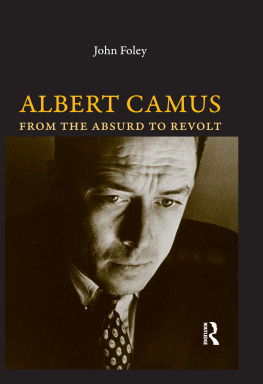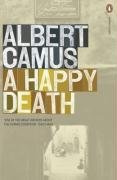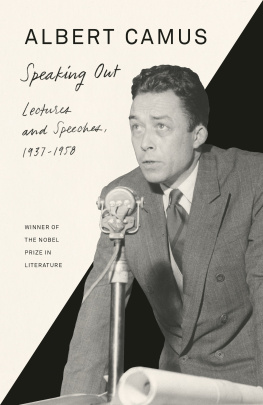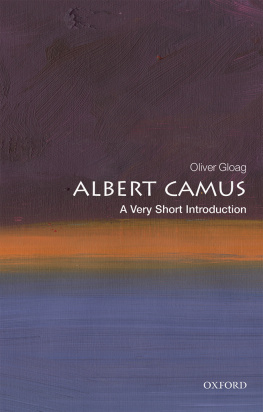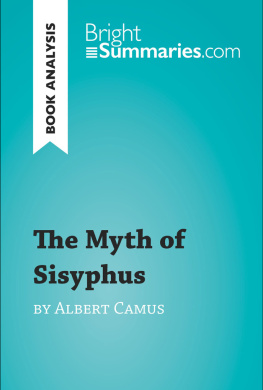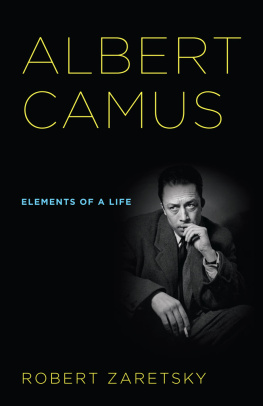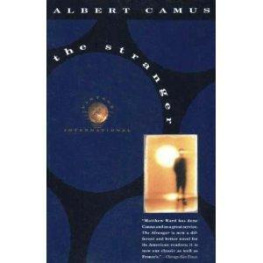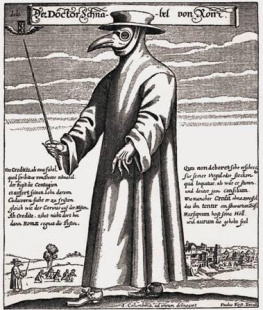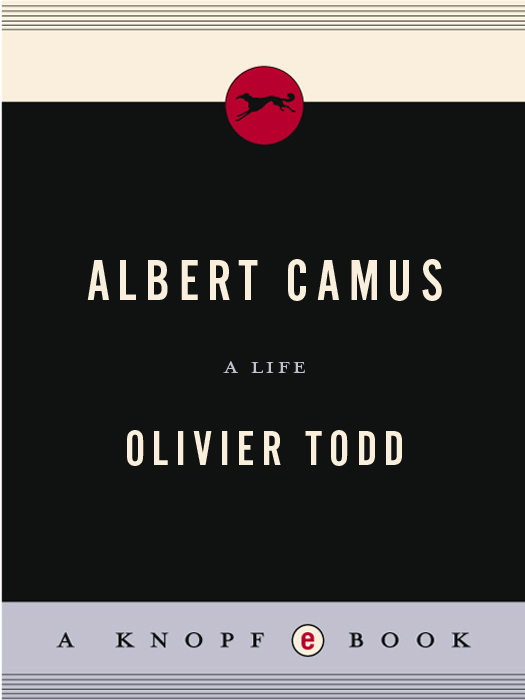THIS IS A BORZOI BOOK PUBLISHED BY ALFRED A. KNOPF, INC .
Copyright 1997 by Alfred A. Knopf, Inc. All rights reserved under International and Pan-American Copyright Conventions. Published in the United States by Alfred A. Knopf, Inc., New York, and simultaneously in Canada by Random House of Canada Limited, Toronto. Distributed by Random House, Inc., New York.
http://www.randomhouse.com/
Originally published in different form in France under the title Albert Camus: une vie, by ditions Gallimard, Paris, in 1996.
Copyright 1996 ditions Gallimard and Olivier Todd
Library of Congress Cataloging-in-Publication Data
Todd, Olivier.
[Albert Camus. English]
Albert Camus : a life / by Olivier Todd ; translated by Benjamin Ivry.
p. cm.
An abridged and edited English version.
eISBN: 978-0-307-80476-1
1. Camus, Albert, 19131960Biography.
2. Authors, French20th centuryBiography.
I. Title.
PQ2605.A3734Z76513 1998
848.91409dc21
[B] 97-2991
The illustrations in this book were provided with the permission and courtesy of ditions Gallimard and the following:
First photographic insert: Camus and Lucien; with Alger Rpublicain colleagues; in Florence: Archives A. Camus/Imec * Enjoying sweet friendship of women: Photo by Marguerite Dobrenn * Bnisti sketches; Bnisti and Poncet: Collection Jean-Pierre Bnisti * Fassina: Collection Pierre Fassina * Self-portrait: Collection Marguerite Dobrenn * Hi: Collection Dr. Cottenceau * As a Don Juan; in new suit: Collection Christiane Galindo * Bourgeois in kayak: Collection Yves Bourgeois * Algerian dossier: Comintern archives * Le Soir Republicain masthead: Bibliothque nationale de France, Paris * Algerian communist tracts: Centre des Archives dOutre-Mer, Aix-en-Provence * Bnichou: Collection Bnichou
Second photographic insert: Letter from Pia; the couple with Pia; with Galindo and Bensoussan: Collection Colette Durand-Dominique * Newlyweds: Collection Bnichou * Letter from Malraux: Collection Florence Malraux * With de Dadelson: Photo copyright Peter Wolff * Malraux and Pascal Pia: Photo copyright Ren Saint-Paul * With Casars and Reggiani; with Barrault and Balthus; with Jean and Catherine Camus: Photographs copyright Bernand * Casars: Photo by Roger Corbeau, copyright Ministre de la Culture, France * Blake: Photo copyright Charles Leirens * FBI file: Federal Bureau of Investigation * Gaston, Michel, and Janine Gallimard; Rene and Robert Gallimard; relaxing at Sorel: Collection Rene Gallimard * Janine Gallimard: Collection Janine Gallimard * Jeanne and Urbain Polge: Collection Jeanne and Urbain Polge * With Sellers: Photo copyright Robert Doisneau/Rapho
All other illustrations are from private collections.
v3.1
Contents
Photographic inserts follow .
Translators Note
The present book is an abridged and edited English version of Olivier Todds biography of Albert Camus, which was published in France in 1996. While all relevant information about the life and work of Albert Camus has been retained, some material not of sufficient interest to the American general reader has been omitted to improve the narrative flow. Anyone seeking more background detail can, of course, consult the original French. The notes at the end of the French edition have also been deleted. While one of the virtues of Todds book is his energetic research, in order to keep the American edition an accessible length we decided to integrate necessary information into the text rather than including the extensive documentation of sources. Again, scholars can turn to the French edition for a full accounting.
I wish to thank Richard Howard for his shining dedication and inspiration at a number of literary tasks, translation among them. At Alfred A. Knopf, Judith Jones provided wise counsel, and she was ably assisted by Kenneth Schneider.
Benjamin Ivry
Preface
The author of LEtranger, never forgetting that he was the noted writer Camus, protected his family and private life. He kept an eye out for the devourer hidden behind every biographer. When critics like Jean-Claude Brisville, Germaine Bre, Roger Quilliot, and Carl Viggiani questioned him about his life, he told them very little.
In 1978, the pioneering biographer Herbert Lottman depicted Camus the man. Ive also attempted to describe him as such, without forgetting that he was a writer. During research in France, Czechoslovakia, and Italy, in conversations with people from France, Algeria, America, and England, while exploring public and private archives, as well as colonial files in Aix and Comintern reports in Moscow, Ive often had the feeling of trying to walk across the horizon. Camus used to say, There is no true creation without secrecy.
This book is entitled Albert Camus: A Life, meaning the one that Ive written. A hundred biographies are possible for every human being. I hope to have revealed the important moments and personalities of one life. I have also based the book partly on eyewitness accounts. Any literary personality has real enemies during his life and as many false friends afterwards. Historians, judges, and biographers run up against the fragility of eyewitness accounts. Thirty-five years after Camuss death, it was time to take stock. Certain of his intimate friends werent known at all or were only slightly known until now. Before Francine Camuss death on December 24, 1979, decency also imposed a certain reserve.
Camus showed Quilliot a typed version of some of his diariesthe backstage of a work, Quilliot remarked. Ive used the Carnets, but sometimes I feel that Camus wrote them with posterity looking over his shoulder, not the way Gide wrote his succulent Journals, but rather with the discretion of Johnson explaining himself to Boswell.
Nevertheless, Camus did not write in code when he put down his observations, thoughts, and adventures, as did Pepys and Hugo. In his letters, the reader is drawn to center stage. I have had the luck of discovering unpublished letters, where an unexpected Camus appears. The authenticity of a letter isnt proof of whether it is sincere. But a letter without too much literary veneer does give the feelings, ideas, and information that a writer wants to convey to its recipient.
Camus once said, The idea that every writer portrays himself in his books is one of the puerilities bequeathed to us by Romanticism. A mans works often describe his longings or temptations, and almost never his own true story. Nevertheless, apart from his successes in artistic transposition, Camuss work is highly autobiographical. Roger Grenier, who knew him, spoke about the writers masks.
In 1959 Camus was asked which part of his work critics had neglected. He replied, The obscure part, what is blind and instinctive in me. French critics are mainly interested in ideas. This rough generalization also describes Camus in the rich French literary, philosophical, and political turmoil from 1930 to 1960.
At age twenty, he wrote, Just as after a writers death we exaggerate the importance of his work, so an individuals death makes us overestimate his personal importance to us. France makes a habit of hagiographic elegies, but later, for years on end, the dear departed may be regularly assassinated.



